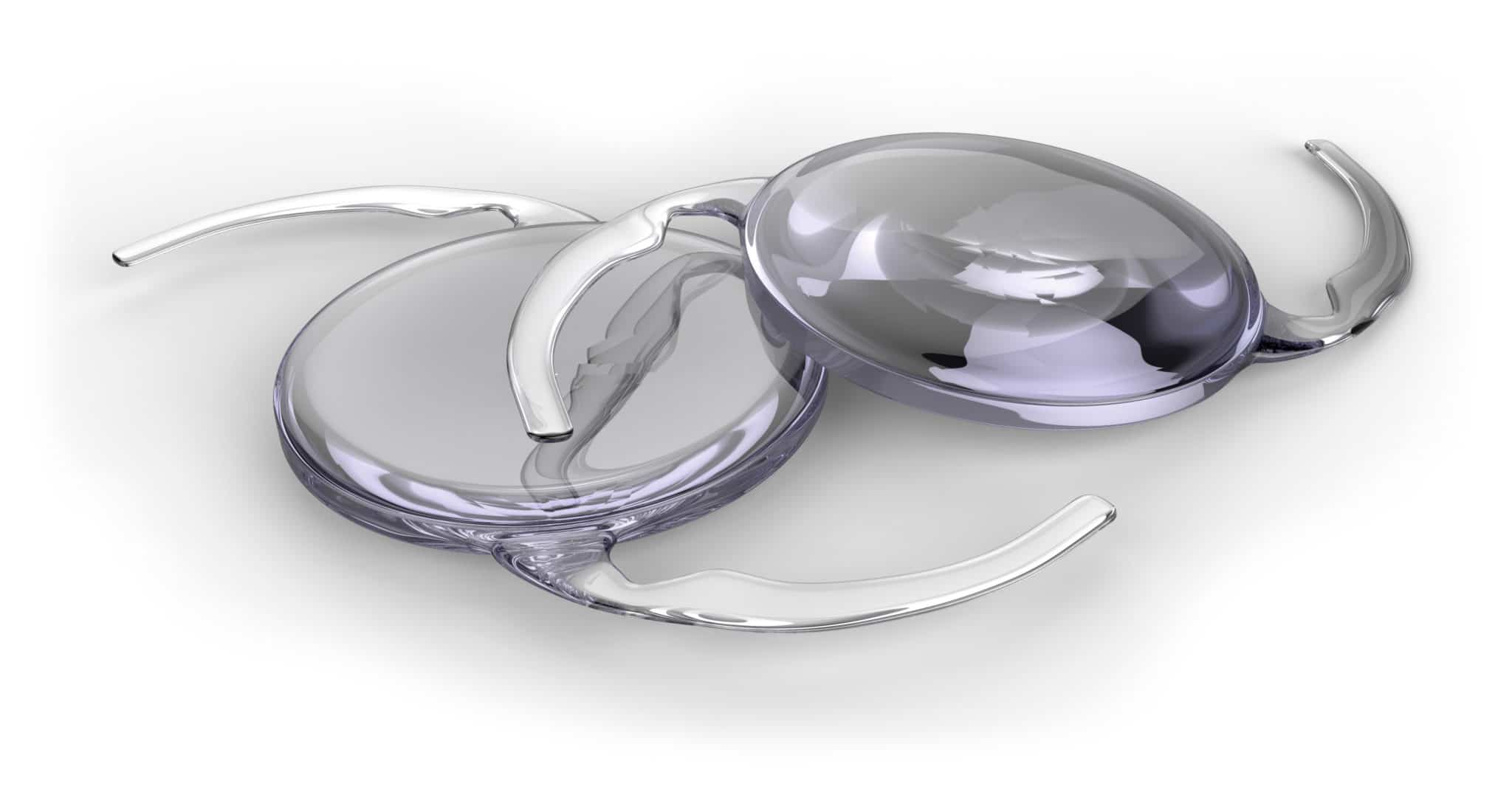What Is Refractive Lens Implant Surgery?
Refractive Lens Implant Surgery is usually recommended to patients over 55 who are not candidates for LASIK. Using methods similar to those in cataract surgery, a ReSTOR® intraocular lens is implanted in place of the eye’s natural lens. This lens allows most patients to experience visual correction without the need for distance or reading glasses or contact lens. Refractive Lens Implant Surgery is done as an outpatient procedure at the Eye Surgery Center of Winchester under local anesthesia and takes approximately 15-30 minutes. In most cases, the patient can return to full activity the day after surgery with functional vision returning to the eye at that point.
Tecnis® Multifocal Lens
Flexible IOLs have been used for years to help patients enjoy clear vision after cataract surgery. The advanced lens improves upon ordinary IOLs by providing a full range of focusing distances.
A series of 12 gradual “step heights” create seamless focusing ability from near to far, while the edge of the IOL enhances distance vision. A feature called apodization also helps the eye distribute light evenly in different lighting conditions. Best of all, up to 80% of patients who use the Tecnis® lens don’t need glasses or contact lenses after surgery.
Phakic Intraocular Lens
Phakic intraocular lenses are recommended for patients who are under age 50 and who are not candidates for LASIK. We currently use the Visian ICL. The Visian ICL is implanted in front of the patient’s natural lens in the posterior chamber (between the iris and natural lens). The new lens helps the patient focus better, leaving the natural lens in place and allowing the patient to “accommodate,” or shift focus between distant and nearby objects. The procedure is reversible.
Is Lens Implant Surgery Right For Me?
Generally, implanting lenses can be a better option for these patients:
- If you’re not a candidate for LASIK or PRK surgery.
- If you’re over 55 and have moderate to severe farsightedness.
- If you’re between the ages of 21 and 45 and you have severe nearsightedness.
- If you have unusually thin corneas.
- If you have irregularly shaped corneas.
- If you have certain eye conditions, including keratoconus and dry eye syndrome.
What Are The Benefits Of Refractive Lens Exchange?
Refractive lens exchange is like an upgrade from your eye’s natural lens that corrects for refractive errors. This can be achieved with LASIK or PRK for most people, but candidates for lens exchange cannot have those treatments. Refractive lens exchange allows the errors to be corrected and the patient can achieve sharper focus. This reduces or eliminates the need for reading glasses or bifocals. The surgery takes just minutes and is exceedingly successful, and recovery is very fast.
How Is Refractive Lens Implant Surgery Performed?
Lens replacement surgery usually takes about 15 minutes and is performed on an outpatient basis at our Winchester offices. Each eye is done separately, usually about a week apart.
The procedure is essentially the same as cataract surgery, which is the most successful surgical procedure in the world. The eye is first numbed with drops. Then the natural lens is removed and is replaced with the Tecnis Multifocal intraocular lens, or another option should the patient desire.
For younger patients, our team implants phakic IOLs, usually the Visian ICL. Rather than removing the natural lens, in these surgeries, the natural lens remains in place and the new lens is placed in front of the natural lens. This is generally used in patients with severe nearsightedness, and the natural lens continues to see up close, while the implanted lens handles medium and distance vision.

What Is Recovery Like After Refractive Lens Exchange Surgery?
Patients are amazed at their immediate vision improvement with both of these procedures. Initial recovery from lens replacement surgery takes about one week, but your vision is usually instantly better. Final results may take a few weeks to fully settle in. You may have some vision disturbances such as blurring, halos, and glare, or a scratchy sensation as your eyes heal. But these all improve and resolve quickly.
After just a week, most patients can begin driving and can return to work. Only now they have perfect 20/20 vision! Both refractive lens exchange and implanted lenses have roughly the same results as LASIK, and they can actually provide better results in some areas, such as better contrast sensitivity compared to LASIK for lens replacement for myopia.
Is Refractive Lens Implant Exchange Permanent?
These are permanent changes. These lenses will not cloud or deteriorate. Both of these procedures are meant to be once in a lifetime surgery. Implanted Tecnis® IOLs for farsightedness replace your natural lenses, so they are permanent, and they also preclude the patient from developing cataracts in the future, since the natural lenses are removed.
The Visian ICLs placed can be removed should your vision change or if you later need cataract surgery. This is because this surgery doesn’t remove the natural lenses.
How Do I Know Which IOL Option Would Be Best For Me?
You’ll have options when choosing your replacement lenses, just as with cataract surgery. During your consultation with our team, we will walk you through your options. We’ll explain why we feel the Tecnis Multifocal IOL is a great choice because it allows vision at all distances and removes the need for the use of eyeglasses for up to 80 percent of patients who’ve had them implanted.

For younger patients with myopia, the Visian ICL is the choice. These lenses have FDA approval for both myopia and astigmatism. They have an astounding 99 percent patient satisfaction rating.
Are Implantable Contact Lenses For Myopia Safe?
The FDA approved Visian ICL for myopia in 2005. It added a second approval for Visian Toric ICL for astigmatism in 2018. These approvals required rigorous testing and research into these lenses, and they have been proven to be very safe. This is evidenced by the 99 percent satisfaction from patients who have had Visian ICL.
These lenses have been approved for use in 63 other countries and over 1,000,000 pairs have been implanted successfully worldwide. In the FDA approval, it noted that 99 percent of patients said they would have Visian ICL surgery again, and 95 percent reported either excellent or very good visual quality with these lenses.
There are risks, as with any surgery, but because these surgeries don’t require any alterations of the cornea, the chances of side effects are lower than with other eye refraction surgeries.
Is Refractive Lens Exchange Safe?
Refractive lens exchange is performed essentially just like cataract surgery, which is one of the world’s most successful surgeries. This procedure involves more risk than LASIK surgery because refractive IOLs are implanted in your eye rather than the laser reshaping your cornea. However, sight-threatening complications are very rare, and most of the complications listed below can be treated successfully with medication or additional surgery. These procedures are best for patients with extreme hyperopia.
Here are the risks involved with RLE:
- Glaucoma
- Infection
- Retinal detachment
- Over-correction
Patient Testimonial
"LOVE this Eye group & staff. Being a medical professional for many years, I have interacted with a higher than an average number of groups from the West coast to here, & this one is professional, polite & kind. The doctors are the best of the best in Opthalmology. So very thankful I found them."
Schedule Your Consultation For Refractive Lens Exchange In Winchester, VA
If you're interested in learning more about refractive lens implant surgery please contact us for a consultation at 540-722-6200 or fill out our contact us form. We will discuss your needs and concerns, and determine your best course of action.


